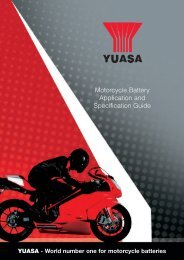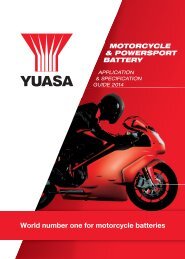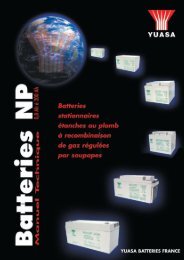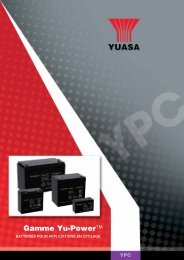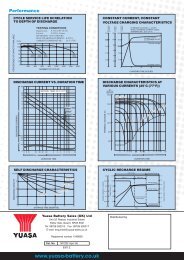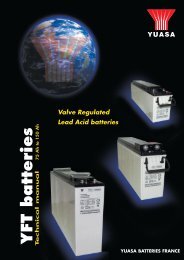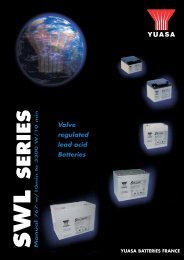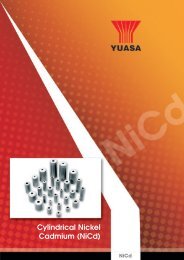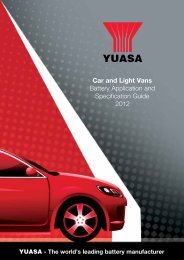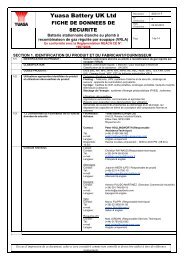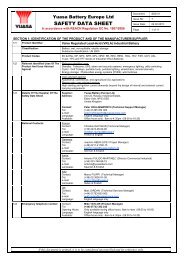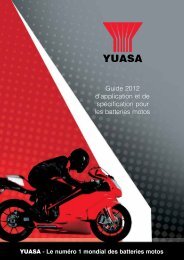YUASA - The world's leading battery manufacturer
YUASA - The world's leading battery manufacturer
YUASA - The world's leading battery manufacturer
You also want an ePaper? Increase the reach of your titles
YUMPU automatically turns print PDFs into web optimized ePapers that Google loves.
Health & Safety Information continued<br />
Information<br />
C - Electrical Energy<br />
<strong>The</strong> Hazard<br />
Accidental short circuit of <strong>battery</strong> terminals by a conductive<br />
object, such as a metal tool or item of jewellery etc. may<br />
generate sufficient heat to cause severe burns, create arcing or<br />
cause any metal to melt and splash.<br />
Severe electrical shocks may be received from faulty mains<br />
electrical charging equipment and during the recharge of high<br />
voltage <strong>battery</strong> systems or the recharge of a number of<br />
batteries connected in series i.e. 5 or more 12V batteries in<br />
series = 60V nominal.<br />
Precautions<br />
Always remove metal objects from hands, wrists & neck e.g.<br />
rings, bracelets, watches & necklaces.<br />
Always, when working on vehicle electrical systems,<br />
disconnect the <strong>battery</strong>, but before disconnection :-<br />
• Switch off all electrical loads<br />
• Refer to vehicle <strong>manufacturer</strong>’s handbook<br />
• Make the first disconnection and the last<br />
reconnection the earth point as far from the <strong>battery</strong><br />
as possible<br />
Always take great care to avoid shorting the live terminal to<br />
earth.<br />
Never place tools or metal objects near to or on top of a <strong>battery</strong>.<br />
Accident or Emergency Action<br />
and Treatment<br />
Burns –<br />
Apply a dry sterile dressing and seek medical treatment.<br />
Electric shock<br />
Approach person with care. If the individual is clear of the<br />
conductor then, with caution, switch off equipment or break<br />
the current. If the individual is still attached to the conductor do<br />
not touch with bare hands. If possible use a suitable insulating<br />
material e.g. wood, rubber, plastic or rolled paper, to detach the<br />
conductor from the victim. If necessary, summon assistance<br />
then give artificial respiration until it arrives.<br />
D - Emission of Gases<br />
<strong>The</strong> Hazard<br />
Hydrogen gas emitted during charging is explosive at<br />
concentration levels above 4%. Hydrogen & oxygen gases are<br />
both evolved during <strong>battery</strong> recharging. <strong>The</strong>se gases may also<br />
be emitted at other times, for example, if the <strong>battery</strong> is moved<br />
or shaken.<br />
Precautions<br />
• Always charge in a well ventilated area<br />
• Always ensure the charging leads are correctly fitted<br />
before switching on the mains<br />
• Always ensure the mains is switched off before<br />
disconnecting the charging leads<br />
• Always use eye protection and protective clothing<br />
• Always wait at least 5 minutes after ceasing recharge<br />
before disconnection<br />
• Always take care to ensure that cables and<br />
connections are handled in a way that avoids<br />
accidental sparking<br />
Never smoke near a <strong>battery</strong><br />
Never allow naked flames near a <strong>battery</strong><br />
Never create sparks near a <strong>battery</strong><br />
Accident or Emergency Action<br />
and Treatment<br />
Seek medical advice as appropriate to injury.<br />
In an explosion acid will have been sprayed and ejected and<br />
plastic & metal parts may have caused severe lacerations.<br />
E - Jump Starting<br />
<strong>The</strong> Hazard<br />
Use of an incorrect procedure when “jump starting” a vehicle<br />
could result in a <strong>battery</strong> explosion, fire and burns to the<br />
individual as well as damage to the vehicle electrical system.<br />
Precautions<br />
Always follow the correct procedure as defined in the vehicle<br />
<strong>manufacturer</strong>s handbook.<br />
In the absence of this information, for a negatively earthed<br />
vehicle :-<br />
1. Make sure the vehicles are not touching and that the<br />
ignition in both vehicles is turned off. Ensure both vehicles<br />
are in neutral or “park”.<br />
2. Connect the positive (red) cable from positive terminal on<br />
one vehicle <strong>battery</strong> to positive terminal on the other vehicle<br />
<strong>battery</strong>.<br />
3. Connect the negative (black) cable to the negative terminal<br />
of the vehicle with the “flat” <strong>battery</strong> – keeping clear from fuel<br />
lines and brake pipes.<br />
4. Connect the negative cable to the negative terminal of the<br />
current supplying vehicle, or to an earthed point on the<br />
vehicle away from the <strong>battery</strong> e.g. engine casing.<br />
5. Ensure all connections are tight and away from moving or<br />
rotating components.<br />
6. Start the engine of the vehicle with the “good” <strong>battery</strong> and<br />
allow to run for one minute.<br />
7. Start the engine of the vehicle with the “flat” <strong>battery</strong> and<br />
allow to run for at least one minute.<br />
8. Stop the engine of the vehicle with the “good” <strong>battery</strong>.<br />
9. Remove the cables in the opposite order keeping them well<br />
away from any moving or rotating components on the<br />
vehicle.<br />
186




